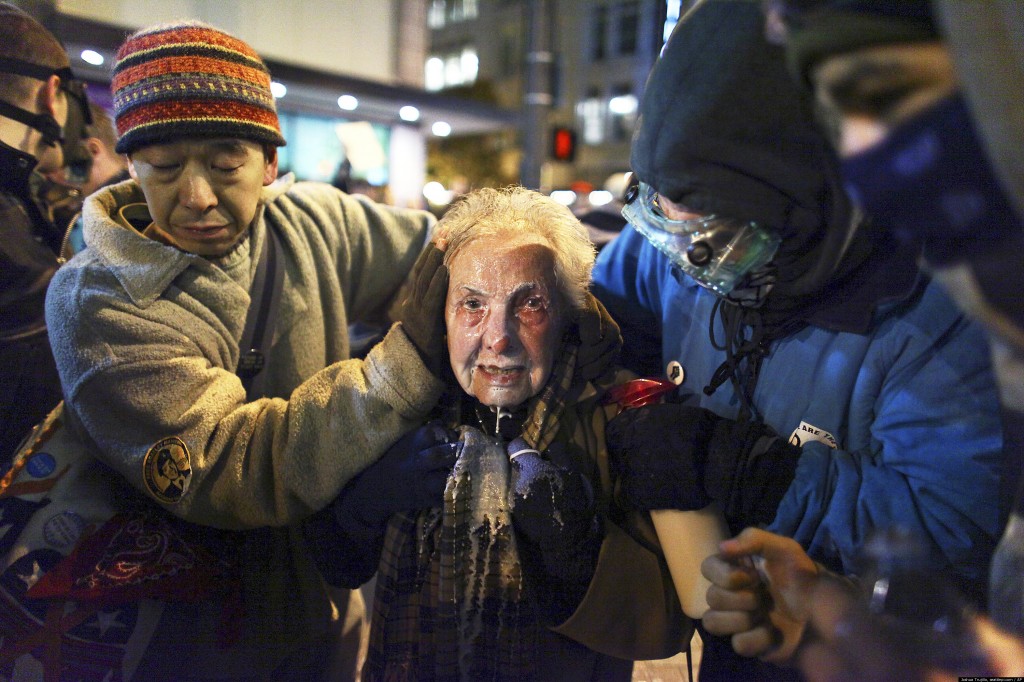The Occupy movement now has its iconic image of martyrdom
By Jonathan Jones, Friday 18 November 2011 09.01 EST
…
Every nascent political movement needs martyrs. Even the sensible British labour movement, whose history is mostly peaceful and overwhelmingly parliamentary, has its memories of the Tolpuddle Martyrs and the Peterloo massacre. Revolutionary traditions fervently venerate their political saints: Irish republicanism has an especially rich pantheon from Pearse and Connolly to Bobby Sands. The Egyptian revolution, less than a year old, already has martyrs including the artist Ahmed Basiony who was shot dead by security forces on 28 January, and whose life and work have since been commemorated at the Venice Biennale.
This week the Seattle police provided the Occupy movement a powerful image of martyrdom. Dorli Rainey was not killed – let’s not overdo any analogies between economic protests in western democracies and the desperate struggle for freedom in Egypt or Syria. She was “only” pepper-sprayed. But she happens to be 84, and photographer Joshua Trujillo happened to be on hand to take a haunting photograph of her reddened eyes and shellshocked expression that subtly and strongly portrays Rainey as a modern martyr.
I am not suggesting this lightly. The martyrdom in Seattle conforms, in Trujillo’s photograph, to the deep religious roots of the idea of suffering for a cause. Rainey resembles a humiliated Christ in this picture. She is supported by two men, one on either side, who both lower their faces – one has his eyes closed in self-protection, the other wears defensive goggles – in what may be a sensible precaution to avoid getting sprayed themselves, but which also looks like a gesture of compassion, of quiet rage and dignified sorrow. It is at once a real moment – the men shielding their eyes while showing her hurt to the camera – and an image straight out of a Christian Renaissance painting.
The men look disconcertingly similar to the supporters of the dead Christ’s tormented body in paintings such as Giovanni Bellini’s The Dead Christ Supported by Angels. The Bellini painting is a great banner of emotion. Bellini depicts Christ nearly naked, his body frontal and wide, the expanse of his pale chest filling the painting with pity: in a similar way, the men supporting Rainey in this photograph frame her strong, striking face, which seems to grow to fill the scene with injured courage. The men display her political wounds just as Bellini’s angels display the spear wound in Christ’s side.
America is a religious nation and I can’t help thinking that either the people in the picture, or the photographer, consciously or unconsciously reached for an image from the iconography of Catholic faith. No movement, in its early history, recognised the power of martyrdom more thoroughly than Christianity did. Obviously, martyrdom is a Christian concept. To die for the faith, by being pinioned to the ground and beheaded – say – or crucified upside down, was to imitate Christ, to reenact the suffering of a God made flesh. The courage of the early Christian martyrs – fact or fiction – provided the church with a popular repository of heroes, relics, and sacred memories. Not all martyrdoms result in death, so even from a pedantic standpoint, Rainey conforms to the tradition – the arrows that pierce Saint Sebastian in so many paintings did not kill him, for instance.
Trujillo’s photograph recreates the image of Christian martyrdom in a modern context in a way that resembles contemporary spiritual artworks such as Bill Viola’s videos – yet it happened in the heat of the moment, on the streets of Seattle. This is not a staged photograph, it is real life. And as such it is a warning to the police and political bosses not to create too many martyrs, if they really want Occupy to disappear.
Lest we sentimentalise radical politics too much, let’s remember that no political movement guarded the memory of its martyrs more fulsomely than National Socialism did. Or that one of the most potent images of secular political martyrdom, David’s painting The Death of Marat, elegises a bloody architect of the Terror in the French Revolution. What does seem to be the case, looking at this photograph and its echoes of Christian art, is that from the time of the French revolution in the 1790s down to today, the idea of suffering for a cause has drifted from the declining cloisters of western Christianity onto the streets and the barricades. As they sing in The Red Flag: “The people’s flag is deepest red/ It shrouded oft our martyred dead.”
…
http://www.guardian.co.uk/commentisfree/2011/nov/18/occupy-movement-iconic-image-martyrdom or http://bit.ly/vhcAry
Photograph of Seattle activist Dorli Rainey, 84, after being hit with pepper spray during an Occupy Seattle protest on Tuesday, November 15, 2011, by Joshua Trujillo/SeattlePI.com. http://www.seattlepi.com/local/komo/article/Elderly-woman-pepper-sprayed-during-Occupy-march-2271197.php or http://bit.ly/tE9LdY

